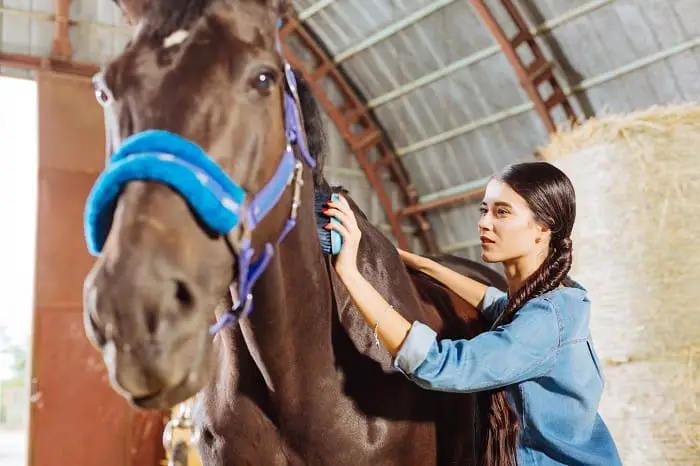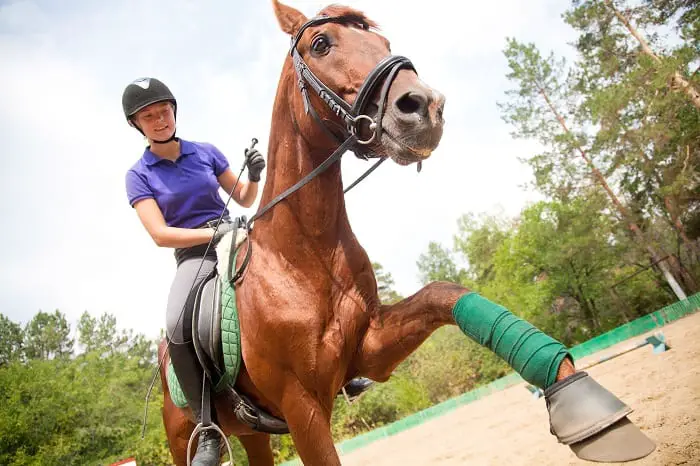Last Updated on December 1, 2021
Do you have a young, unbroken horse that you’re not sure what to do with? Or do you have a foal on the way? When is the best time to train a horse? Then this article may be for you! Starting a young or baby horse correctly is essential for that horse’s success.
But, there’s a whole world of difference between working with a young or baby horse and working with a green-broke horse. A horse that has already been saddled, and maybe ridden a few times (i.e.- “green-broke”) has at least seen what his job will look like.
All of these things and more, I will be discussing in this article. The best time to train a horse is as soon as it takes its first breaths. But, horse training is a long and very involved process that takes place over a lifetime. It’s essential to go at the right pace for the horse to be successful.
When is the Best Time to Train a Horse
A baby horse, or a very young horse, has never seen a halter, never seen an arena, and never seen you. So, how and when do you start working with this baby? And how quickly can you introduce new things? And how do you introduce new things without compromising his growth and development?
Handling (0-6 or 9 months)
Basic horse handling should happen as soon as a foal puts its feet on the ground. Foals should be touched and handled by as many people as possible, in order to get them used to human contact.
Think of this stage like socializing a young puppy. You want a foal to be exposed to the very basics of being a horse. People should be touching him, interacting with him, going in and out of his stall or pasture, etc.
You should also be introducing him to very basic things that he will be encountering. He should be haltered and introduced to a lead rope. He should be introduced to hay and water buckets. He should be allowed to go out in a pasture with his mom. At this point, he could also be introduced to indoor and outdoor arenas with his mom.
The more exposure a foal gets at this stage of his life, the better. Brushes, blankets, grooming stalls, pastures, arenas, etc. etc. Let him see it all!
GroundWork (6 months- 2 years)
During this stage of a horse’s life, you should begin incorporating ground-work and manners. This is really a continuation of teaching him how to be handled. It’s important your horse learns ground manners and basic body language as a youngster so that he is respectful when he gets bigger and heavier.
This can also be called “in-hand” work. Much of it comes from your horse understanding that he needs to move away from pressure. Your horse should know that he is to move over when you put pressure on his haunch, or on his shoulder.
He should understand how to walk in-hand, to stop when you stop, and to go when you go. He should (eventually) understand how to stand still for decent amounts of time, to prepare him for being tacked up later on in his life.
Some people begin lounging their horses during this time period as well. That way the horses can start learning verbal cues such as “Woah” and clucking.
When is the Best Time to Train a Horse: Saddling (2-4 years)
Of course, everyone wants to know when they can start the process of teaching their young horse to be ridden. And, many, many people begin this stage too early. Check out the below image of a horse’s skeletal development, from EquineLink.com.
As you can see, a horse’s bones don’t completely stop growing until they are six years old! Yet many people think they should start riding horses when they are younger than three. Pay special attention to the horse’s legs and leg joints in the chart.
These legs and leg joints should NOT be subject to the weight of a rider until they have been fully developed. In fact, many renowned trainers say that a horse should not bear the weight of a rider until it is four years old, at least.
However, there are many things you can do to prepare your horse for riding during this stage of his life! While the weight of a rider might be too much at this age, the weight of a saddle certainly isn’t. Saddles, especially English ones, typically weigh less than 20 pounds. And, getting your horse used to wearing a saddle, girth, saddle blanket, and bridle can be a lengthy process.
Each article should be introduced separately and slowly. Many horse trainers use a round pen to introduce tack to a young horse. Young horses can be lodged with tack on to begin developing their muscles.
When is the Best Time to Train a Horse: Riding (4+ years)
Experts’ best estimate today is that it is safe to start riding horses at about four years old. At this point, your horse should have gone through lots of exposure, basic groundwork, and an introduction to tack.
Once his joints and bones have developed enough to carry a rider, it’s time to start teaching him the ropes. But, always, always, always consult your vet. Though most horses develop at roughly the same rate, there are always exceptions.
You want to make sure your horse is sound, happy, and strong before you put a rider on his back.
Conclusion
So, when is the best time to train your horse? As soon as your horse takes its first breath. But, the stages of horse training look very different depending on how old your horse is and where he is in his development.
Starting your horse slowly and correctly is the best thing you can do to help his future successes. Young horses have lots of things to take in and understand that older horses are simply used to. Many of these things we don’t even realize.
So, the best bet to start a young horse is to make sure his riding training lines up with the stage of life he is in. Make sure as many people handle him and approach him as possible. Get him used to the sights and sounds that he will experience every day for the rest of his life.
I hope this article helped you better understand when to start training your horse. If so, please share this article, and share with us your experiences training young horses!
FAQs
At what age can you start lunging a horse?
There is no right or wrong answer to this question as it depends on the individual horse and what you are hoping to achieve through lunging. However, a good rule of thumb is to start lunging horses when they are around five years old.
Lunging is a great way to improve your horse's muscle tone, balance, coordination, responsiveness, and confidence. Lunging also works to improve your horse's ability to respond to leg aids. There are two ways to do it: through the use of an overhead or ground lunge line. With both methods, you can work on straightness, bend, and flexion. However, only the ground-lunge method will allow you to work on responsiveness to leg aids.
It is best not to begin lunging before five years old as younger horses are still growing, and their muscles, bones and joints are still developing. If you start lunging a horse before this age, you run the risk of causing joint and muscular problems later.
It is recommended that you only lung a young horse for about 10-15 minutes per session and no more than three times per week. Of course, if your horse needs more or less lunging time then you should adjust accordingly.
At what age do horses knees close?
Horses begin to close their knee joints when they are four years old.
The closing of the knee joints is a process that takes place over a period of time, and it is important that horses do not bear weight on their hind legs until the tendons and ligaments have sufficiently closed around the joints. If they do, they can develop bowed tendons, which is a condition that can affect their performance in the future.
It is therefore important that horse-owners are aware of when their horses' knees have closed. This varies from horse to horse, so it is important to monitor each individual carefully.
How often should you train with a foal?
In order to ensure a foal grows into a healthy horse, it is important to train with them on a regular basis. However, how often you should train depends on the age of the foal.
Foals that are under one year old should be trained once a week. During this training session, you should focus on teaching basic obedience commands, such as 'stand', and 'come'.
Foals that are between one and two years old should be trained twice a week. In addition to continuing to teach basic obedience commands, you should also start training the foal in more advanced maneuvers, such as backing up and turning.
Foals that are over two years old should be trained three times a week. At this age, the foal should know all basic obedience commands, and you can start training them in more complicated maneuvers, such as flying changes and piaffe. This is also a good age to start training for things like dressage, eventing, or show jumping.
You should be aware that training a young horse can become difficult as they reach adolescence. It is recommended that training sessions should be kept short and fun during this time, as training a young horse in the wrong way can lead to them becoming 'bitted out' and uncooperative.
What happens if you start training your horse too early?
Many problems can arise if you begin training your horse before it is ready, including behavioural issues and training injuries. These training problems can affect your horse later in life when it is fully grown, causing poor performance due to physical problems in the horse's joints and muscles (such as bowed tendons, navicular syndrome, arthritis), and causing the horse to become uncooperative.
Michael Dehaan is a passionate horse owner, horse rider, and lover of all things equine. He has been around horses since he was a child, and has grown to become an expert in the field. He has owned and ridden a variety of horses of different breeds, and has trained many to compete in shows and competitions. He is an experienced horseman, having worked with and competed many horses, including his own. He is an active member of the equestrian community, participating in events and teaching riding lessons.


